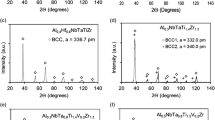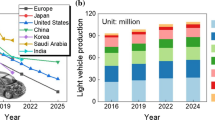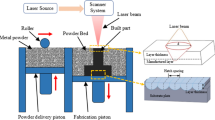Abstract
The feasibility of fabricating fiber-reinforced aluminum alloys by addition of discontinuous fibers to vigorously agitated, partially solid metal slurries was investigated. In the first phase of the program, reported herein, emphasis was placed on the study of interface interactions between polycrystalline A12O3 fibers and Al-2 to 8 pct Mg, Al-4.5 pct Cu and Al-4.5 pct Cu-1 to 2 pct Mg alloys. In general, it was observed that the incorporation of fibers could be readily achieved by this technique, and that fibers appeared wetted after a few minutes of contact with the melt. The composites produced exhibited an intimate, void free bond between the constituents. In addition, a region of significantly altered microstructure resulted from accumulation of oxide and/or aluminate particles which either formed within the melt and were attached to the moving fibers, or used the fiber surface as a substrate to grow on. Microscopic examination of this interaction zone and thermodynamic considerations indicate that it consists of fine α-Al2O3, aluminates, oxides of the alloying elements, and probably some intermetallic compounds. For example, it is shown that a stable MgAl2O4 spinel forms at the interface of A12O3 fibers and Al-Mg alloys. Examination of composite specimens fractured under tension indicated that the interfaces produced were strong enough to permit the transfer of loads at strengths in the order of 250 to 350 MPa.
Similar content being viewed by others
References
L. J. Ebert and P. Kennard-Wright:Composite Materials, 1st ed., vol. 1, p. 31, Academic Press, New York, 1974.
A. G. Metcalfe and M. J. Klein:Composite Materials, 1st ed., vol. 1, p. 125. Academic Press, New York, 1974.
W. H. Sutton:Whisker Technology, 1st ed., p. 273, Wiley Interscience, N. Y., 1970.
A. P. Levitt:Whisker Technology, 1st ed., p. 245. Wiley Interscience, N. Y., 1970
R. L. Mehan:Metal Matrix Composites, p. 29, STP 438, ASTM, 1968.
M. J. Moore, E. Feingold and W. H. Sutton:Interfaces in Composites, p. 90, STP 452, ASTM, Philadelphia, Penn., 1969.
R. L. Mehan:J. Compos. Mater., 1970, vol. 4, p. 90.
A. K. Dhingra and W. H. Krueger:Fiber FP, Continuous Alumina Yam, Report by E. 1. Dupont de Nemours and Co., Inc., Wilmington, Del., 1974.
K. M. Prewo: Report R77-912 245-3, Contract N00014-76-C-0035, United Technologies, East Hartford, Conn., May, 1977.
D. T. Live and P. Murray:Plansee Proc, 2nd Seminar, (Reutte, Tyrol, 1955), pp. 375–404, 1956.
R. D. Carnahan, T. L. Johnson and C. H. Li:J. Amer. Ceram. Soc., 1958, vol. 41, pp. 343–47.
K. Prabriputaloong and M. R. Piggott:Surface Sci., 1974, vol. 44, pp. 585–97.
M. Nicholas:J. Mater. Sci., 1968, vol. 3, pp. 571–76.
S. M. Wolf, A. P. Levitt and J. Brown:Chem, Eng. Progr., 1966, vol. 62, pp. 74–78.
J. A. Champion, B. J. Keene and J. M. Sillwood:J. Mater. Sci., 1969, vol. 4, pp. 39–49.
J. Brennanand, J. A. Pask:J. Amer. Ceram. Soc., 1968, vol. 51, pp. 569–73.
R. E. Tressler:Composite Materials, 1st ed., vol. 1, p. 285, Academic Press, New York, 1974.
W. A. Weyl: Proc. No. 46, p. 506, ASTM, 1946.
G. Katz:Thin Solid Films, 1976, vol. 33, pp. 99–105.
J. G. Lindsay, W. T. Bakker and E. W. Dewig:J. Amer. Ceram. Soc., 1964, vol. 47, pp. 90–94.
J. J. Comer, N. C. Tombs and J. F. Fitzgerald:J. Amer. Ceram. Soc., 1966, vol. 49, pp. 237–40.
M. W. Shumate:Interactions of Molten Aluminum with Phosphate Bonded A1 2O3 Refractories M. S. Thesis, University of Illinois, Urbana, Ill., 1977.
A. Sato and R. Mehrabian:Met. Trans. B, 1976, vol. 7B, pp. 443–51.
K. T. Jacob and C. B. Alcock:J. Amer. Ceram. Soc., 1975, vol. 58, pp. 192–95.
O. Kubaschewski, E. LI. Evans and C. B. Alcock:Metallurgical Thermochemistry, 4th ed., Pergamon Press, New York, 1967.
R. Hultgren, P. D. Desai, D. T. Hawkins, M. Gleiser, and K. K. Kelley:Selected Values of the Thermodynamic Properties of Binary Alloys, ASM, Metals Park, Ohio, 1973.
Author information
Authors and Affiliations
Rights and permissions
About this article
Cite this article
Levi, C.G., Abbaschian, G.J. & Mehrabian, R. Interface interactions during fabrication of aluminum alloy-alumina fiber composites. Metall Trans A 9, 697–711 (1978). https://doi.org/10.1007/BF02659927
Received:
Issue Date:
DOI: https://doi.org/10.1007/BF02659927




